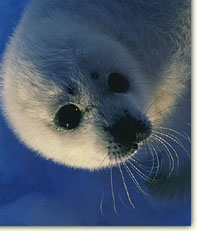
Seals
Phocidae
Seals swim in Arctic waters eating fish like arctic cod as well as crustaceans and mollusks. Their rear flippers are turned backward. This improves their swimming, but makes it difficult to move around on land because their toes point backwards. Try walking around with your toes pointing backwards! Instead they prefer sliding around on the ice.
One species, the ringed seal, spends most of its time beneath the ice. It digs up through the ice with its strong claws to open breathing holes and must keep pushing it nose through the ice to keep the holes from icing over. This is easier than making new holes, but if they aren't careful a polar bear will see their hole and catch them.
Seals are great divers and can stay under water for long periods of time without returning to the surface for a breath. Mature seals mate in the spring. Calves are born in the spring of the following year, and stay with their mothers for a few weeks until they are able to catch prey for themselves. Besides, their soft baby fur is not warm enough to be alone, and they must wait until their white fur has changed to a darker thicker pelt better suited for arctic waters.
Seals were over hunted by humans for many years, but now many seal species are protected and can only be caught by native people in the Arctic.

